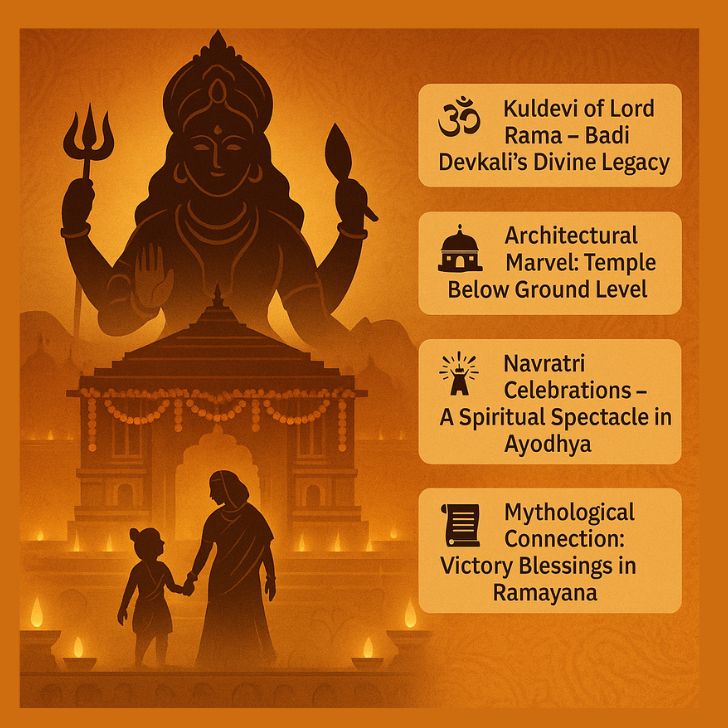🛕 Badi Devkali Mandir, Ayodhya: A Forgotten Jewel in Lord Rama’s Divine Journey
Ayodhya, the spiritual heartland of India, is more than just a city—it’s a living story. Among its many sacred shrines, one temple quietly holds a unique place in the divine life of Lord Rama: the Badi Devkali Mandir.
This temple isn’t just another spiritual stop—it’s where the divine and the familial meet. Here’s the story of the Kuldevi (family goddess) who blessed Lord Rama himself.
🙏 Meet Goddess Badi Devkali – Lord Rama’s Kuldevi
In Hindu tradition, every family has a Kuldevi or Kuldevta—a guardian deity worshipped for generations. For Lord Rama, that divine protector was Goddess Badi Devkali. Her temple in Ayodhya still echoes with the devotion that once connected her to the royal family of Raghuvansh.
This isn’t just mythology—it’s living legacy.
🌸 A Temple Steeped in Spiritual Energy
As Ayodhya prepares for major celebrations like the Shri Ram Lala Pran Pratishtha on January 22, temples across the city glow with renewed vibrance. But Badi Devkali Mandir stands out—not with size or crowds, but with soul.
The temple comes alive with flower decorations, traditional lights, and an energy that feels both ancient and fresh. Pilgrims from every corner of India come here seeking blessings, peace, and that special connection with Lord Rama’s divine mother figure.
🛕 A Place of Pilgrimage & Powerful Stories
Visiting this temple isn’t just a stop on a tour—it’s an emotional and spiritual journey. When you walk into Badi Devkali Mandir, you walk into Rama’s family story. It’s said that as a child, Lord Rama visited this very temple with his mother, Mata Kaushalya.
Imagine that moment—a young Rama, holding his mother’s hand, visiting the deity who would one day bless him for the great war in Lanka.
That connection isn’t just spiritual. It’s personal. And it’s timeless.
📖 The Ancient Legacy of Raja Raghunath
According to sacred legends, it was Maharaja Raghunath, an ancestor of Rama, who established this temple. He didn’t just build a structure—he began a tradition. Under Goddess Badi Devkali’s blessings, it’s believed that Rama’s victory over Ravana was made possible.
To this day, that victory—and the power behind it—is honored here.
✨ The Triple Divine Presence Inside
Step into the sanctum sanctorum, and you won’t meet just one goddess. Here, Mahakali, Mahalakshmi, and Mahasaraswati—the three cosmic energies—reside together. It’s rare. It’s sacred. And it’s powerful.
Worshippers come seeking:
Strength and protection (Mahakali)
Wealth and abundance (Mahalakshmi)
Wisdom and knowledge (Mahasaraswati)
All under one roof.
🧱 Temple Below Ground: Symbolism That Speaks Volumes
One of the most fascinating parts? The temple is constructed below ground level. Why? It’s symbolic—devotees believe it shows the goddess looking up to Lord Rama, a divine gesture of humility and reverence.
That’s not just architecture—it’s a spiritual metaphor.
🎉 Navratri: When Devotion Meets Celebration
If you ever visit during Navratri, get ready to be amazed. The temple transforms into a grand darbar (court) of Lord Rama. With chants, lights, and hundreds of devotees, it’s more than celebration—it’s a declaration of faith.
This isn’t just a religious event. It’s a cultural explosion that ties Ayodhya’s past with its present.
❤️ A Living Temple in a Living City
As Ayodhya reclaims its glorious place in India’s spiritual landscape, Badi Devkali Mandir quietly continues to bless, guide, and protect. It’s not just a temple—it’s a bridge between mythology and today, between Lord Rama and every devotee who walks in with hope.
So next time you’re in Ayodhya, don’t miss the chance to experience this sacred space. Not just to witness history—but to become part of it.
✨ “In every prayer offered here echoes a blessing once given to a prince who became a god. That’s the magic of Badi Devkali Mandir.”
Ayodhya’s spiritual transformation over the decades has captivated millions, especially with the monumental rise of the Ram Mandir. If you want to explore this incredible timeline, from December 6, 1992, to January 22, 2024, don’t miss this in-depth feature titled “A Majestic Saga: Ram Mandir’s Transformative Journey – Unveiling Divine Adornments in Ayodhya!”. This article celebrates Ramotsav 2024, showcasing how the temple became a beacon of unity, devotion, and cultural revival.

